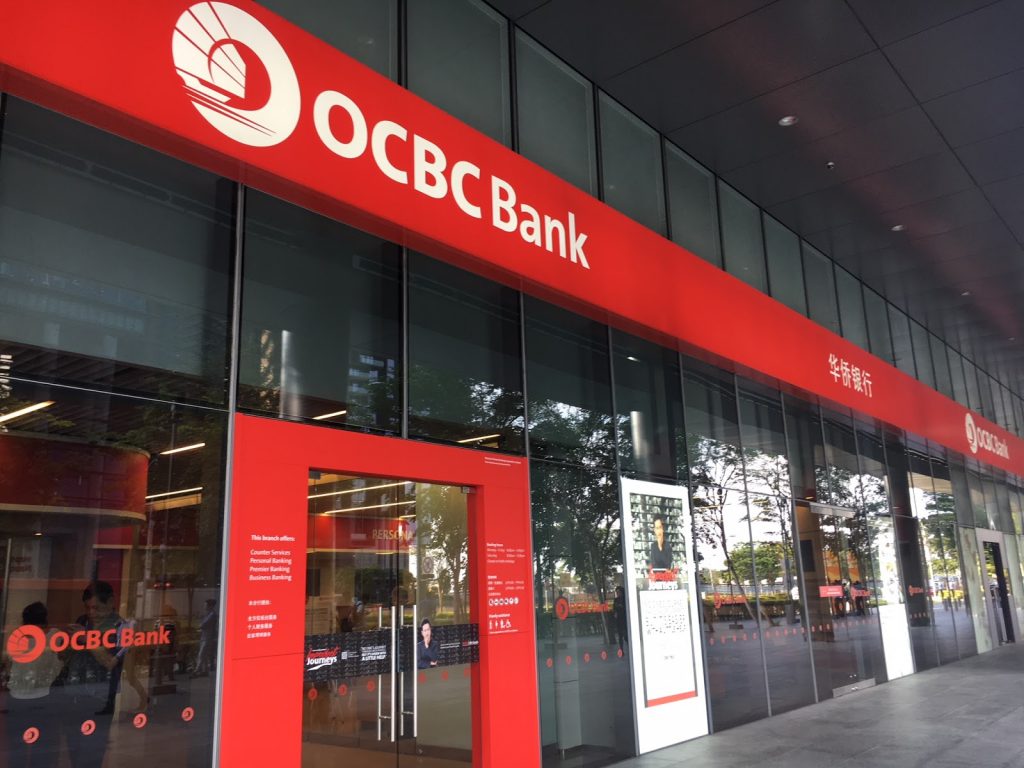List Of Banks in Singapore
| BANK NAME | ADDRESS | TELEPHONE | OPERATING HOURS |
| DBS Group | 12 Marina Boulevard, Marina Bay Financial Centre Tower 3, Singapore, 018982 | 65 6327 2265 or 65 6878 8888 | Monday – 8:30AM–4PM Tuesday – 8:30AM–4PM Wednesday – 8:30AM–4PM Thursday – 8:30AM–4PM Friday – 8:30AM–4PM Saturday – 8:30AM–12:30PM Sunday – Closed |
| Overseas Chinese Banking Corporation | 65 Chulia Street, OCBC Centre, Singapore 049513 | 65 6363 3333 | Monday 9AM–4:30PM Tuesday 9AM–4:30PM Wednesday 9AM–4:30PM Thursday 9AM–4:30PM Friday 9AM–4:30PM Saturday 9–11:30AM Sunday Closed |
| United Overseas Bank | 80 Raffles Pl, #1 UOB Plaza, Singapore 048624 | 1 800 222 2121 | Monday 9:30AM–4:30PM Tuesday 9:30AM–4:30PM Wednesday 9:30AM–4:30PM Thursday 9:30AM–4:30PM Friday 9:30AM–4:30PM Saturday 9:30AM–12:30PM Sunday Closed |
| Citibank Singapore | 8 Marina View Asia Square Tower 1, #21-00. Singapore 018960 | 65 6224 5757 | Monday 9:30AM–6PM Tuesday 9:30AM–6PM Wednesday 9:30AM–6PM Thursday 9:30AM–6PM Friday 9:30AM–6PM Saturday Closed Sunday Closed |
| HSBC Singapore | HSBC Collyer Quay Branch, 21 Collyer Quay #01-01 /, #02-01 (Premier Centre), Singapore 049320. |
800 216 9008 | Mon: 9:00 to 5:00 Tue: 9:00 to 5:00 Wed: 9:00 to 5:00 Thu: 9:00 to 5:00 Fri: 9:00 to 5:00 |
| Maybank Singapore | 2 Battery Rd, Maybank Tower, Singapore 049907 | 800-777 0022 | Monday – Friday: 9.15 am to 4.45 pm. Saturday: 9.15 am to 12.15 pm (Closed on Sunday and Public Holidays) |
| Standard Chartered Bank | Marina Bay Financial Centre (Tower 1, 8 Marina Blvd, #01 – 01, Singapore 018981 | 65 6747 7000 | Monday 10AM–5PM Tuesday 10AM–5PM Wednesday 10AM–5PM Thursday 10AM–5PM Friday 10AM–5PM Saturday Closed Sunday Closed |
| Bank Of Singapore | 63 Market St, #22-00 Bank of Singapore Centre, Singapore 048942 | 65 6559 8000 | Monday 9AM–6PM Tuesday 9AM–6PM Wednesday 9AM–6PM Thursday 9AM–6PM Friday 9AM–6PM Saturday Closed Sunday Closed |
| SBI Singapore | 139 Cecil St, Singapore 069539 | 65 6228 1116 | Monday 11AM–5PM Tuesday 11AM–5PM Wednesday 11AM–5PM Thursday 11AM–5PM Friday 11AM–5PM Saturday Closed Sunday Closed |
| Bangkok bank Singapore | 180 Cecil St, Bangkok Bank Building, Singapore 069546 | 65 6410 0400 | Monday 9:30AM–3:30PM Tuesday 9:30AM–3:30PM Wednesday 9:30AM–3:30PM Thursday 9:30AM–3:30PM Friday 9:30AM–3:30PM Saturday Closed Sunday Closed |
| CIMB Bank Singapore | 30 Raffles Pl, #03-03, Singapore 048622 | 65 6333 7777 | Monday 9AM–4:30PM Tuesday 9AM–4:30PM Wednesday 9AM–4:30PM Thursday 9AM–4:30PM Friday 9AM–4:30PM Saturday 9AM–1PM Sunday Closed |
| ICICI Singapore Bank | 6 Raffles Quay, Singapore 048580 | 65 800 101 2553 | Monday 11AM–3PM Tuesday 11AM–3PM Wednesday 11AM–3PM Thursday 11AM–3PM Friday 11AM–3PM Saturday Closed Sunday Closed |
| RHB Singapore Bank | 90 Cecil St, Singapore 069531 | 65 1800 323 0100 | Monday 9AM–4:30PM Tuesday 9AM–4:30PM Wednesday 9AM–4:30PM Thursday 9AM–4:30PM Friday 9AM–4:30PM Saturday 9AM–1PM Sunday Closed |
| Bank of India Singapore | 158, Cecil Street, #01, #02. Singapore 069545 | 65 622 20011 | Monday – Friday 10.00 am to 3.00 pm Saturday & Sunday Closed. |
| Indian Overseas Bank Singapore | 64 Cecil St, IOB Building, Singapore 049711 | 65 6225 1100 | Monday 9:30AM–4PM Tuesday 9:30AM–4PM Wednesday 9:30AM–4PM Thursday 9:30AM–4PM Friday 9:30AM–4PM Saturday Closed Sunday Closed |
| ANZ Singapore | 10 Collyer Quay, Level 20 Ocean Financial Centre, Singapore 049315 | 65 6681 8033 | Monday 8:30AM–5:30PM Tuesday 8:30AM–5:30PM Wednesday 8:30AM–5:30PM Thursday 8:30AM–5:30PM Friday 8:30AM–5:30PM Saturday Closed Sunday Closed |
| J.P. Morgan Singapore | One@Changi City, Changi Business Park Central 1, Singapore 486036 | 65 6882 2888 | Monday 8AM–5PM Tuesday 8AM–5PM Wednesday 8AM–5PM Thursday 8AM–5PM Friday 8AM–5PM Saturday Closed Sunday Closed |
| Hong Leong Finance | 16 Raffles Quay, #01-05 Hong Leong Building, Singapore 048581 | 65 6415 9118 | Monday 9AM–4:30PM Tuesday 9AM–4:30PM Wednesday 9AM–4:30PM Thursday 9AM–4:30PM Friday 9AM–4:30PM Saturday 9AM–12PM Sunday Closed |
| BNP Paribas Singapore | 10 Collyer Quay, Singapore 049319 | 65 6224 3459 | Monday: 9AM–6PM Tuesday: 9AM–6PM Wednesday: 9AM–6PM Thursday: 9AM–6PM Friday: 9AM–6PM Saturday: Closed Sunday: Closed |
| OCBC Singapore | 65 Chulia Street, OCBC Centre, Singapore 049513 | 65 6224 3459 | 11.00am to 7.00pm from Mondays to Fridays and 11.00am to 1.30pm on Saturdays. The branches will be closed on Sundays and Public Holidays. We encourage customers to bank with us digitally where possible |

Introduction :
Singapore is a thriving financial hub of repute that serves the whole Asia Pacific area in addition to its domestic economy. The nation’s banking sector, which is quickly becoming one of the strongest in the world, is a significant player in the financial market. Singapore is Asia’s third-largest international finance companies after Japan and Hong Kong. This status gets attributed to factors including a stable economic and political climate, favorable legal and tax regulations, a reputation for integrity, and difficult enforcement against financial crime and money laundering. The majority of banks in the financial industry now are six local banks and 117 foreign institutions. The following elements have helped the banking sector in Singapore succeed:
- Market liberalization for domestic banks.
- Through mergers and acquisitions, local banks expanded their geographic reach.
- Foreign banks‘ growth, some of which turned Singapore into a regional or global hub for essential banking services, boosted competition.
- More intense rivalry encouraged the creation of novel items and aggressive price strategies.
- The bank provides customer service through 3,000 branches in India and six overseas locations.
- Private banking has increased strict banking secrecy laws, tax-friendly legislation, and different wealth management consultancy firms. To meet growing demand from Asian and European clients, Swiss behemoths Credit Suisse Group and UBS AG have expanded their private banking operations in Singapore.
The Monetary Authority of Singapore’s (MAS) function, the major local and foreign companies and the services they offer, key trends, essential participants in the industry today, and banking regulations are all covered in this overview of the banking sector in Singapore.
What banks are there in Singapore?
We offer a thorough list of banks in Singapore that includes all the details you require for these banks. A hundred eleven commercial banks, 49 merchant banks, and 45 banks with representative offices are present in Singapore. The Monetary Authority of Singapore oversees the banking sector in Singapore. The list of banks in Singapore is provided below, in no particular order.
ANZ Singapore bank:
Of the two authorized ANZ regional centers in Asia, Singapore is one.
The Australia and New Zealand Banking Group’s representative office get first established in 1974. In 1980, it gave offshore bank status and improved S.A. Wholesale Bank status.
Bangkok bank Singapore:
In one of the major financial centers of the Asia Pacific region, the Bangkok Bank Singapore branch offers comprehensive commercial banking services.
Bank of India Singapore:
The Bank of India has been operating in Singapore since June 4th, 1951, and holds Domestic and ACU licenses. The Singapore office gets conveniently situated in the Central Business District for the benefit of clients.
BNP Paribas Singapore:
The international banking firm with a French base, BNP Paribas, has a presence in South East Asia through its subsidiaries in Indonesia, Malaysia, the Philippines, Thailand, and Vietnam.
CIMB Bank Singapore:
The regional coverage offered to its clients by CIMB Bank Berhad Singapore considers local conditions. CIMB capitalizes on the potential for small businesses to develop into global giants by providing a complete variety of continuous banking products and services to SMEs and medium-sized firms.
Citibank Singapore:
The first American bank branch to build a branch in Singapore was Citibank Singapore, a subsidiary of the US-based global banking conglomerate Citigroup.
DBS Bank:
In June 1968, the Singaporean government formed DBS Bank, formerly The Development Bank of Singapore Limited.
Hong Leong Finance:
A division of the Hong Leong Group, Hong Leong Finance (HLF), offers financial services in Singapore.
HSBC Singapore:
One of the earliest banks in Singapore was created in December 1877 and is known as HSBC Singapore (subsidiary bank of The Hongkong and Shanghai Banking Corporation Limited).
ICICI Singapore bank:
A subsidiary of the biggest bank in India, ICICI, which is active in 19 different nations worldwide, is ICICI Bank Singapore Limited.
Indian Overseas Bank Singapore (IOB Singapore):
The Indian Overseas Bank, one of the largest retail banks with its headquarters in Chennai, runs IOB in Singapore as a branch.
The bank offers customer service abroad and has more than 30,000 branches throughout India.
Islamic Bank of Asia:
Located in Singapore, The Islamic Bank of Asia (IB Asia) is a bank that specializes in merchant banking services such as direct investment, consulting, treasury, and capital markets.
J.P. Morgan Singapore:
The headquarters of the leading international financial services business, J.P. Morgan, with operations in more than 60 countries and assets worth over USD2.3 trillion, is located in Singapore.
Maybank Singapore:
A branch of Maybank, the biggest bank in Malaysia, Maybank Singapore is a commercial bank with operations a full license. Through a distribution network of 22 Branches and more than 35 ATMs, it has been operating in Singapore since December 1960 and now offers highly customized services and locally focused strategies.
OCBC Bank Singapore:
Financial institution OCBC Bank, also known as the Oversea-Chinese Banking Corporation Limited, was established in Singapore in 1932.
By market value, the bank was Singapore’s biggest neighborhood bank in 2010.
RHB Bank Singapore;
One of the large banking groups in Malaysia, RHB Bank Berhad, has a branch in Singapore called RHB Bank Singapore.
SBI Singapore:
The State Bank of India, which owns SBI Singapore, is the biggest commercial bank in India with assets, deposits, profits, branches, customers, and staff.
Standard Chartered Singapore:
The global financial establishment, main office in London, United Kingdom, includes Standard Chartered Singapore as a subsidiary. A network of 19 branches, 7 Priority Banking centers, and 31 ATMs make up the bank’s current network, which it first established in the nation in 1859.
UOB Singapore:
A bank with its headquarters in Singapore that conducts business in Southeast Asian nations is called UOB Singapore (United Overseas Bank Limited).
What is the best bank in Singapore?
- DBS
- Group Overseas
- Chinese Banking Corporation
- Bank of Singapore
- Citibank Singapore
- CIC Singapore
- HSBC Singapore
- Maybank Singapore
- Standard Chartered
- Bank RHB Bank
Which bank has the most ATMs in Singapore?
Most people in Singapore have a bank account there. DBS/POSB ATMs are practically ubiquitous, which is convenient during busy times, except in long lines. Singapore ex-pats can use the DBS Multiplier Account as suitable all-around savings account daily. If it’s your first DBS bank account, there is no minimum balance requirement, and you can earn 1.55% p.a. interest or more as long as you credit your paycheck to the bank account and use a DBS/POSB credit card to make any purchases (which you will, this being Singapore).
UOB offers more ATMs than DBS or POSB, and the wait times are substantially lower. UOB account holders may also use OCBC ATMs. The UOB One account, their great savings option, operates similarly to the DBS Multiplier. You can earn at least 1.85% p.a. in interest if you charge at least $2,000 of your monthly wage and $500 or more on some UOB Smart Credit Card each month.
Which bank is best for savings in Singapore?
Savings accounts provide a terrific method to increase the interest on your money without having to take significant risks or give up access to it for a long time. Some accounts let customers earn up to 3.50%+ p.a. on their savings, making it simple to earn money quickly and with little work. In Singapore, various savings account kinds, each specifically designed for some user. There are different options with fewer criteria and lower risk, even though the accounts with the highest likely interest rate frequently have a lot of conditions. To help you determine which savings account best meets your needs, we’ve carefully examined Singapore’s most competitive savings accounts and have provided thorough and comparative assessments below.
- CIMB FastSaver Savings Account
- DBS Multiplier Account
- UOB One Account
- OCBC 360 Account
- Maybank SaveUp Account
- Standard Chartered Bonus Saver
- Bank of China Smart Saver
- POSB SAYE Account
Which bank is most reliable in Singapore?
Banking in Singapore has achieved extraordinary success. Only 280 square kilometers of land make up the little state, which only gained independence in 1965. But it has become a significant global financial actor in just fifty brief years. Singapore, recognized as an international financial hub, has over 100 banks.
Bank for Development of Singapore (DBS):
The Developmental Bank of Singapore, or DBS, was immediately behind Singapore’s independence in 1965. Since its establishment in 1968, the bank has expanded quickly to rank among the top banks in the world. How about that trophy case? DBS has been named the great bank in the world for three years in a row. To provide banking appropriate for the digital era, it recently launched a program with the tagline “live more, bank less.” A fun tidbit about DBS’s history: Two staff members set up mobile offices at shipyards and manufacturers to better serve the workforce. Additionally, they opened their first location in Jurong.
Overseas-Chinese Banking Corporation (OCBC):
Because the OCBC Bank’s famous headquarters held the record for Southeast Asia tallest building, it dominates the banking sector in Singapore in more ways than one. With over 340 billion dollars in assets, OCBC is second only to Singapore in wealth. In addition, OCBC was recognized for excellence in digital innovation and wealth management, winning the title of the best retail bank in Singapore. OCBC Bank is not a stranger to that way of thinking. The bank established a night drop deposit method back in 1948 so that its clients could deliver their cash earnings without having to wait until the next daybreak. Additionally, you could claim that OCBC created one of the first mobile banking applications.
The United Overseas Bank (UOB):
Before Singapore became independent, UOB dominated the banking industry. It began in 1935 and has continued despite years of conflict and occupation. Naturally, the institution has given stability and security priority. The “quiet family bank” has recently started making more audacious efforts to increase its online visibility.
Standard Chartered:
A global financial organization with nearly a century of experience in banking includes Standard Chartered Bank in Singapore. With 60 markets and 85,000 employees, the multinational firm considers diversity its main competitive advantage. Given their history in Singapore, they have honored their pledge to be “here for good.” Long before the country gained independence, in 1859, it established its first branch. It was Among the first banks to grant a government-issued Qualifying Full Bank, or QFB, license in 1999.
Which bank is best for foreigners in Singapore?
Some foreigners in this country find it challenging to choose which bank is best for them as newcomers. To put it simply, foreigners should choose from the banks listed below in Singapore as they are the best.
UOB:
Foreign non-residents can open personal savings and current accounts at United Overseas Bank (UOB), the third-largest bank in Singapore. A general UOB account will charge monthly fees ranging from S$2 to S$5 if the average balance is less than the initial minimum deposit of S$500.You must physically be present in Singapore to engage in an in-branch meeting where you must provide a letter of recommendation from your previous bank or a letter from a UOB introducer to get things started.
OCBC:
The best bank in Singapore for foreigners is OCBC. OCBC, short for Overseas-Chinese Banking Corporation, is one of Singapore’s top banks for foreigners. Given that it has numerous branches outside of Singapore, this bank is appropriate for foreigners.
Additionally, it offers several international branches that make it easy for you to do financial transactions everywhere. Many foreigners and ex-pats consider it the most dependable bank in Singapore because of the bank’s strong service guarantee.
Standard Chartered:
The best bank in Singapore for foreigners is Common Chartered. Selecting Standard Chartered is an additional choice. It’s been operating in Singapore for a while now and is an American bank. The bank provides various services, including savings accounts, credit card accounts, and many others. Therefore, it gets advised that everyone in Singapore, especially foreigners, use this bank for their important savings accounts while they are there.
Citibank:
Citibank is the best bank for foreigners in Singapore. In Singapore, Citibank is the second-best bank for foreigners. This bank has a good reputation and has been around for a while. As an American bank, Citibank provides services offline and online. Many foreigners use Citibank as their account for company or payroll because of its competitive rates and low service fees.
HSBC:
HSBC is the best bank in Singapore for foreigners. Hong Kong and Shanghai Banking Corporation, also known as HSBC, is one of the top banks in Singapore for foreigners. This bank gets founded in Hong Kong, but it later expanded globally, opening numerous offices.
Singapore, which provides a wide range of services for housing numerous ATMs across the country, is one of the sites. HSBC is one of the reputable banks that is appropriate for foreigners because of this. A bank is an excellent option if you want to save money or carry out regular financial activities in Singapore at minimal cost because it supports good customer services and products.
A DBS Bank:
DBS Bank is the best bank for foreigners in Singapore, and Expats and foreigners in Singapore tout DBS Bank Limited as a top bank. DBS established its first branch in Marina Bay, Singapore, and has since expanded. There are several ATMs located all around the nation. Additionally, it offers its customers a variety of financial services. Up-to-business loans are used for business expansion, starting with savings accounts to fund daily transactions. Due to the bank’s digital offerings, many foreigners use DBS Bank as their primary account.
Which bank is the most secure in Singapore?
Banks in Singapore are among the most secure in the world. Even during difficult times and when the world was in disarray, Singapore has never experienced a bank failure in its 43-year history. DBS Bank, OCBC Bank, and United Overseas Bank (UOB) ranked by Global Finance magazine in 2011 at 19, 25, and 26.

These Singaporean banks were ranked higher than other, larger, and more established institutions like JP Morgan Chase, Deutsche Bank, and Barclays. Additionally, these Singapore banks rank among the top 3 in the same poll for the Asian continent. Singapore’s banking secrecy regulations have evolved during the last ten years. Banks in Singapore are permitted to share information for purposes including deliberate tax evasion under a revised version of the Banking Act (Cap 19) of Singapore. Only inquiries from public entities get backed up by substantial and trustworthy evidence to substantiate a tax evasion charge are accepted.
Can I open a bank account online without going to the bank in Singapore?
In contrast to other nations, Singapore typically enables you to open a bank account without ever going to a branch. However, you can physically enter a bank if you prefer (and you happen to be in the country already).
You may sign up online with the majority of Singaporean banks. Go to the bank’s website to apply, where you can fill out the form online and provide scanned copies of the necessary paperwork. If you don’t have a work or school pass, this may not apply to you, in which case the bank may demand you to come in person and present other forms of identification.
How to open a bank account in Singapore?
It might be challenging to open a bank account in Singapore without a Singapore address and documentation proving your legal right to be there. Some banks offer a discount to clients who intend to relocate to Singapore soon. You might be allowed to register an account using a foreign proof of address, but if you move to Singapore, you’ll need to amend it to reflect your new address.
Non-residents may have difficulty opening accounts in Singapore, but visitors who have a valid pass and documentation of a local address should not encounter any issues. Banks have different procedures; some let you apply online, while others demand that in person to a location. Online account opening is frequently limited to a few types of accounts and targeted primarily towards Singaporean and Permanent Resident consumers. Whether you LOAN APPLY in person or online, you typically need to have the following:
- Evidence of identity
- Evidence of address
- Your letter of in-principle approval (IPA) or current permit
- A fully filled-out application with your personal banking information
- Opening deposit: a minimal deposit may be needed.
- Some banks could need a referral from your home bank or an introducer.
What is the minimum amount to open a bank account in Singapore?
Here are the required minimum deposits to open an account with a reputable Singaporean bank.
UOB:
A standard UOB current account will charge monthly fees ranging from S$2.00 to S$7.50.00 if the average amount is less than the initial minimum deposit of S$500.
A DBS Bank:
The monthly costs for your account could range from S$2.00 to S$7.50, depending on the kind. Online account applications are also an option.
OCBC Bank:
For most OCBC bank accounts, the initial minimum deposit is $1,000.00. Annual account fees are waived the first year for several OCBC bank accounts.
Maybank Singapore:
A monthly service fee (approximately S$2.00) gets charged to maintain the account with Maybank Singapore, with the average minimum initial deposits for savings accounts being S$500 and current accounts being S$1,000.
HSBC Singapore:
A S$5.00 monthly fee gets assessed when the average daily monthly balance for most accounts falls below S$2,000.00. The minimum initial deposits for current charges and savings accounts are US$2,000.00 and US$1,000.00, respectively.
Standard Chartered Singapore:
At Standard Chartered Singapore, the minimum initial deposits vary greatly and range from a hefty S$5,000.00 for the “Cheque & Save” account to S$0.00 for the “SuperSalary” account. You can start an online application to open an account.
How long does it take to open a bank account in Singapore?
It depends, which is a disappointing response. You might finish an application in 10 to 15 minutes if you’re starting an account online and have all the necessary paperwork together in advance (or less). It can take a day or two for your application to be processed and for your account number to be issued. The simplest but not always the quickest way to do so is by opening a bank account online.
It can take longer if you open an account in person ( 30 minutes to an hour or more). If you don’t make an appointment in advance, you might have to wait a long. If you have cash that has to deposit, this is the preferred method of creating a bank account. If all of your paperwork is in place, it won’t take long for your account to start working correctly.











